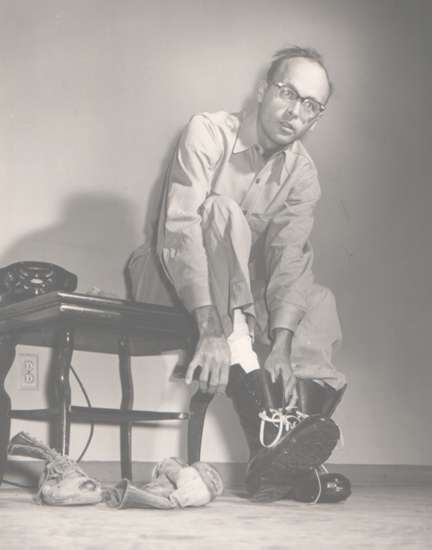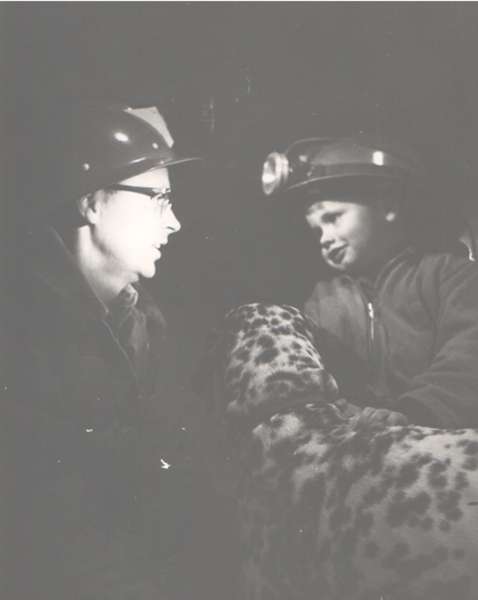

A few days after the Denver Post published its closely worded story about my father’s Big Indian uranium discovery, Moab’s Times-Independent ran an article based on the same announcement that Dad had given to the Denver newspaper. Although the Times-Independent article actually contained more details about the high-grade nature of the uranium mineralization contained in the discovery drill core, not a single person among the newspaper’s readership expressed any interest in helping Dad develop his prospect. None of the area’s long-time uranium prospectors and miners were convinced that Charlie Steen had really found a uranium bonanza. Folks laughed when they heard that someone from Texas was claiming to have discovered a million dollars worth of uranium in a mining district that everyone knew the experts had already examined and written off as a loser.
In early September, Dad received a letter postmarked Casper, Wyoming from William T. Hudson, his former boss at the Chicago Bridge and Iron Company’s Houston, Texas office. Bill Hudson had overseen the college loans that my father worked off during the summers and had written to congratulate him after reading the Denver Post article.
AT LONG LAST! Charlie tries on a new pair of boots.
Dad immediately telephoned Bill Hudson and explained the situation. He told Hudson that McCormick’s interest was available for $15,000 and that he needed at least another $35,000 to prove up the ore deposit. Hudson, a family man, told my father that he couldn’t risk more than $5,000. But he was still associated with Dan O’Laurie, another of Dad’s old bosses at Chicago Bridge and Iron. Hudson approached the thrifty O’Laurie about raising the necessary money. A day later Dan O’Laurie flew down from Casper to size up the proposition.
After he saw the drill core samples and verified the chemical analysis results, O’Laurie caught some of Charlie Steen’s enthusiasm for his uranium prospect. He put up $15,000 and agreed to loan the venture another $30,000. Hudson came across with his $5,000 and Bob Barrett chipped in another $4,500. Dan O’Laurie and Bill Hudson bought out Bill McCormick and his cautious silent partner while my father considered his options.
Instead of spending all of the remaining capital drilling more holes to block out the ore body, Dad decided to gamble all of the money to sink a shaft down to the uranium indicated by his single discovery drill hole on the Mi Vida claim. It was bad geology but good economics, because if they had drilled more exploratory holes they would have been out of money; but a shaft would enable them to begin production immediately.
A small crew of miners was hired and a head frame and hoist house were constructed along with a bunkhouse and cook shack. On October 4, 1952, a six-by-eight foot shaft was started thirty feet southeast of the discovery drill hole. While my father examined and recorded the geology, Bob Barrett oversaw the shaft sinking, and my grandmother, Rosalie Shumaker, did the cooking. Dan O’Laurie moved to Moab and handled the finances, and Bill Hudson anxiously awaited the results in Wyoming. My mother and brothers and I continued to live in Cisco where our friends, the Cowgers and the Seeleys helped Mom get along during Dad’s absences.
Two weeks later, my father drove into Moab and introduced himself to Mitch Melich, the only lawyer in town. He wanted to form a closely held corporation and he wanted to name it the Utex Exploration Company after the two states of Utah and Texas. Melich agreed to incorporate the company and come on board as corporate counsel in exchange for a small percentage of Utex stock.
In retrospect, it was a good thing that Moab didn’t offer Charlie Steen a large selection of attorneys to choose from, because Mitch Melich brought a lot of experience and ability to Utex. Melich had grown up in the copper mining town of Bingham Canyon, Utah. He had worked for Kennecott as a young man during the summers in order to pay his way through college. More importantly, he was married to Ed Snyder’s daughter. Snyder had been involved in mining for decades, and he had many years of experience in metallurgy and mineral processing as president of the Combined Metals Reduction Company. Mitch Melich and Charlie Steen liked one another immediately. Melich became my father’s closest ally in the many negotiations and mining deals that followed this initial meeting.
The Utex Exploration Company was formed on October 24th, with Dan O’Laurie as president; William T. Hudson vice-president; Robert M. Barrett vice-president in charge of mining operations; Charles A. Steen chief geologist and secretary-treasurer; and Rosalie Shumaker as assistant secretary-treasurer. Dan O’Laurie’s closest friend, Allan P. Darby, was later appointed assistant to the president. My father and his mother retained 51 percent of the corporation’s 50,000 shares in exchange for Dad’s contribution of 12 of his mining claims.
Because the soft sedimentary rock formations had to be timbered and the waste rock hand mucked and hoisted to the surface in a quarter ton ore bucket, the shaft sinking progressed very slowly. Finally, at a depth of 68 feet, the miners blasted into the Mi Vida ore horizon. My father and his mother and their partners gathered around the slowly growing ore pile at the base of the head frame and handled and examined the heavy uranium ore as it was brought to the surface in the ore bucket.
When the miners had mucked out the last drill round that had penetrated the Mi Vida ore deposit, my father excitedly climbed down the shaft ladder and found himself surrounded by the same grayish-black formation he had pulled up in his drill core back in July. It was the first time any geologist had ever seen such high-grade uranium ore on the Colorado Plateau. This was the reward for years of hardship and privation. This was the fulfillment every prospector dreams of when he sets out to find a fortune. It was the first day of December, and it was Dad’s thirty-third birthday. Charlie Steen had truly struck it rich!
Everybody took the weekend off so that the Utex insiders could let their family and friends know that the prospect had become a mine. My father and his mother drove through Moab in the red jeep on their way to Cisco to celebrate and make plans with my mother. It was 10 o’clock at night and the whole town was locked up and fast asleep. A student of mining history, my Dad knew that his discovery was going to change the time Moab went to bed. The sleepy little town was about to wake up.
The shaft bottomed after passing through more than 8 feet of primary uranium ore that ran between 0.34 and 5.0 percent uranium oxide. During its first 12 days in operation, the Mi Vida mine only produced 114 tons of ore, but it averaged over $100 per ton and some of it was worth more than $800 per ton. And it was almost all profit, because mining and hauling costs were less that $20 per ton.
My father contacted the Denver Post to confirm his discovery. After they ran a follow-up story about the rags to riches saga of the young prospector-geologist and his loyal wife, the press descended on the Mi Vida mine site. In addition to the Denver Post, the Grand Junction Daily Sentinel and the Salt Lake Tribune wrote the first of countless articles about Charlie Steen and his uranium strike. These articles caught the attention of the public and fueled the rush of people that overwhelmed Moab, Monticello, Blanding and Grand Junction in search of fortunes of their own.
In the mine: Charlie, Butch and Mark.
The articles that appeared in mining industry magazines attracted mining companies, geologists, mining engineers, prospectors and promoters from all points to the Colorado Plateau in search of another Mi Vida mine. The Big Indian mining district became the uranium magnet for most of these migrants. More millionaires were made on the Lisbon Valley anticline than any other uranium mining area in the United States. Charlie Steen’s assertions that he had found a million-dollar mine ignited the Uranium Boom.
Although it was soon obvious that the Mi Vida mine had enough uranium ore to make all of the principal Utex shareholders wealthy, disputes about the company’s operation and direction erupted almost as soon as production commenced. The first disagreement arose when O’Laurie and Barrett leased a two hundred-by-six hundred foot section of the Mi Vida claim to the G and G Mining Company without informing my father (who was out of town) or consulting Mitch Melich (who would have advised against the lease).
Then in the early summer of 1953, a wealthy man named Dandridge made an offer of $5 million to purchase the Mi Vida mine for a group of Easterners. He was willing to pay $1 million down and the balance out of production. O’Laurie and Barrett wanted to sell out before the mine played out. My Dad refused to consider a sale before he knew the extent of the Mi Vida ore deposit. By the time the offer expired, the Mi Vida mine had already shipped more that $1 million worth of ore and production exceeded 200 tons a day from the new decline that Utex had to share with the G and G Mining Company.
As a geologist, my father realized that the Mi Vida ore deposit was not diminishing in size or grade. He firmly believed that it would eventually exceed a million tons. A noted Canadian geologist, Andrew K. McGill, my father’s old boss and mentor from Peru, shared his professional opinion. Andy McGill had joined Utex and was helping Dad get a handle on the geology and exploration potential of the extensive claim block around the Mi Vida mine. McGill thought that the Mi Vida mine was world class, but he didn’t think much about Bob Barrett’s ability to manage the mine.
In August, 1953, Charlie Steen was quoted saying that "We need to build a mill down here to process our ore. I will build a mill in Moab one of these days. It will also help to serve the many small miners in the area." It was estimated that a mill would cost between $3 million and $5 million.
Dan O’Laurie refused to go along with my father’s plans to build the first independently owned, modern uranium processing mill in America. He pointed out that Utex didn’t have that kind of money and that the AEC would never negotiate a buying contract with a single uranium producer. O’Laurie was also sure that the established uranium processing companies would never stand aside and let Utex compete with their highly profitable, government sanctioned monopoly.
Lines were drawn and sides were taken. Barrett and O’Laurie thought of their interests in Utex as an investment. Charlie Steen thought of the Mi Vida mine as the investment of his lifetime. It represented his success against tremendous odds. Dad viewed his discovery as proof that all of the experts who had derided his abilities were wrong. He still harbored a grudge against the AEC for the things that the government geologists had said about him and his abilities. In fact, he would not allow any AEC geologists on the property. When the government wanted to inspect the source of all of that uranium ore that was over-crowding the buying station at Thompson, Charlie Steen insisted that no AEC geologists could be part of the team that mapped and sampled the Mi Vida mine. When he was quoted as saying, "You know, it’s a funny thing. Before I hit pay dirt, people called me crazy. When I hit it, they called me a charlatan. Now that I’ve got it, they call me lucky," he was thinking about those same AEC geologists. And when people called him lucky he invited them to come try their luck. There was plenty of unstaked country on the Colorado Plateau for people who thought that all it took was luck to find uranium.
Tempers finally boiled over in October. After a heated argument, my father told Dan O’Laurie to get out of the Moab office. Then he had the locks changed on the doors. Later that day, Dad and Mitch drove out to the mine to fire Bob Barrett as mine manager. In their view, Barrett may have been a good pinto bean farmer, but his mine management left everything to be desired. Dad seethed every time he thought about the millions of dollars that the ill advised G and G Mining Company lease was going to cost Utex. Things turned ugly and got physical between Barrett and Melich before that corporate meeting was concluded; but Barrett and most of his crew left the Mi Vida mine after my father officially fired him. This scuffle in the cook shack was always referred to as the "Battle of the Cook Shack" whenever the subject of Barrett and O’Laurie came up in conversations.
Bob Barrett and Dan O’Laurie hired a lawyer to contest their ousters as corporate officers and directors; and they threatened to tie up the Utex Exploration Company by placing it in receivership. After things cooled down, Mitch Melich began negotiations to purchase Barrett and O’Laurie’s shares in order to settle the dispute. My father grew impatient and made them an offer they couldn’t refuse. He agreed to pay Barrett and O’Laurie $175 a share for their 18,500 shares of Utex stock.
The transaction cost my Dad $3,272,500 plus interest. Dan O’Laurie, who had been my father’s boss when he was a teenaged water boy on a construction site in Texas, received $2,310,000 in principal payments for his $15,000 investment (his $30,000 loan had been the first money paid out of Utex’s profits). Bob Barrett, who had known my father during his hungry prospecting days, received $787,500 in principal payments for his $4,500 investment and his helping hand. Ten other shareholders, who O’Laurie had previously sold 1,000 shares of his stock in Utex to after the mine began to ship ore, received $175,000 in principal payments. And Max Cohen, a Dallas, Texas attorney trousered $281,000 for his representation of Barrett and O’Laurie. Mr. Cohen was the first in a long line of lawyers who profited from the millions of dollars made at the Mi Vida mine.
The terms of the December 12, 1953 sale and purchase of the stock provided for an initial payment of $150,000 upon signing. The balance of the purchase price was to be paid within 10 years with interest payable semi-annually at the rate of 2.5 percent per annum on the unpaid principal. The sellers didn’t make much money off the interest, because they were all paid off within a couple of years. They sold their interests in the Mi Vida mine before more than 1 percent of the ore body had been blocked out.
An article about the transaction that appeared in the Daily Sentinel quoted Charlie Steen as saying, "This settles an irreconcilable conflict of interest." The story went on to disclose that, "Mr. Steen recently announced that he is negotiating with the Atomic Energy Commission to build a processing plant at Moab." The Daily Sentinel also broke the news that my father had recently optioned the Big Buck claims adjacent to the Mi Vida mine.
In the next installment, Mark will describe how Charlie Steen and Bill McCormick helped form Standard Uranium in order to develop the Big Buck mining claims. And he will tell how the Mi Vida mine’s cook made $500,000 and why the claim jumpers missed a $50,000,000 opportunity.









